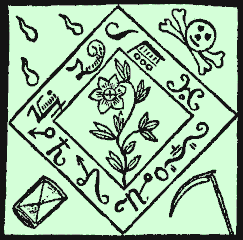Grimoire
From Thelemapedia
Categories: Magick | Grimoires
Part of the Magick in Theory & Practice series.
A grimoire is a book of magical knowledge written between the late-medieval period and the 18th century. Such books contain astrological correspondences, lists of angels and demons, directions on casting charms and spells, on mixing medicines, summoning unearthly entities, and making talismans.
The word grimoire is from the Old French gramaire, and is from the same root as the word grammar. This is partly because, in the mid-late Middle Ages, Latin "grammars" (books on Latin syntax and diction) were foundational to school and university education, as controlled by the Church — while to the illiterate majority, non-ecclesiastical books were suspect as magic. But "grammar" also denoted, to literate and illiterate alike, a book of basic instruction.
Notable historical grimoires include:
- The Book of the Sacred Magic of Abra-Melin the Mage
- Liber Juratis, or, The Sworn Book of Honorius
- The Black Pullet
- The Greater Key of Solomon
- The Lemegeton, or, the Lesser Key of Solomon
In the late 19th century, several of these texts (including the Abra-Melin text and the Keys of Solomon) were reclaimed by neo-Masonic magical organizations such as the Hermetic Order of the Golden Dawn and the Ordo Templi Orientis. Aleister Crowley, a prime mover of both groups, then served as a vector for a number of modern movements, including Wicca, Satanism, and Chaos Magic.
A cottage industry has existed since the 19th century in selling false or carelessly-translated grimoires (many original texts are in French or Latin, and are quite rare), although faithful editions are available for most of the above titles.
A modern grimoire is the Necronomicon, named after a fictional book of magic in the stories of author H.P. Lovecraft, and inspired by Sumerian mythology and the Ars Goetia, a section in the Lesser Key of Solomon which concerns the summoning of demons.
External links
- Secrets of the Magickal Grimoires (http://kheph777.tripod.com/indexsecrets.html)
- A collection of grimoires (http://www.sacred-texts.com/grim/)
- Grimoires Ebooks (http://www.hermetics.org/ebooks.html)
- The Grimoires Collection from Sacred-Magick.Com | The Esoteric Library (http://www.sacred-magick.com/PDF.html)
References
- Wikipedia (2005). Grimoire (http://en.wikipedia.org/wiki/Grimoire). Retrieved Nov 18, 2005

![[Main Page]](http://www.thelemapedia.org/images/logo.gif)